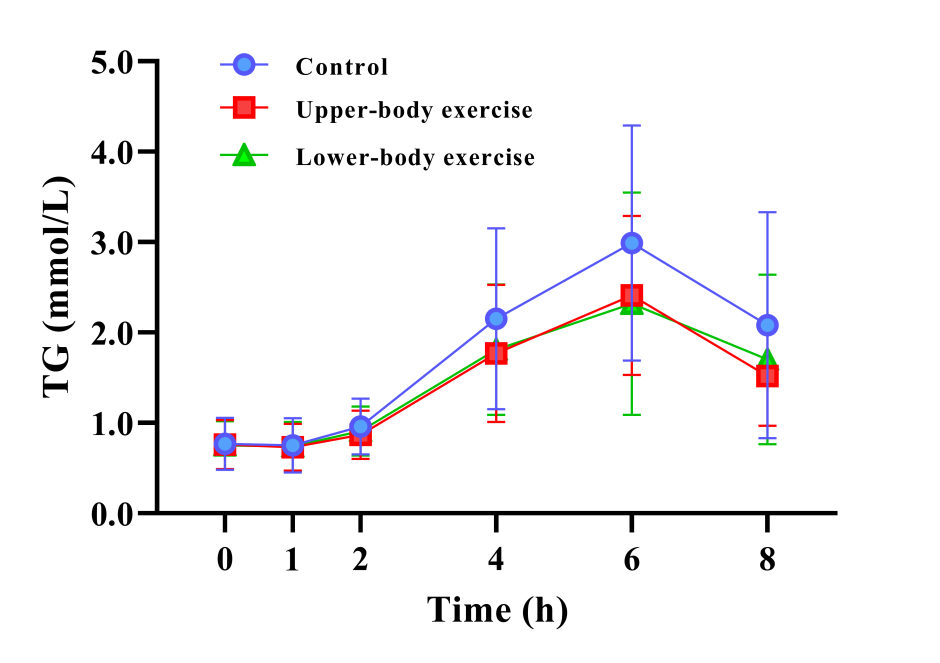- NEWS
- The effect of upper- and lower-body exercise on next-day postprandial triglycerides in healthy young men/上肢と下肢の運動が翌日の食後中性脂肪濃度に及ぼす影響
The effect of upper- and lower-body exercise on next-day postprandial triglycerides in healthy young men/上肢と下肢の運動が翌日の食後中性脂肪濃度に及ぼす影響

- Posted
- 2024年10月28日(月)
Abstract
Our research group has revealed that energy-matched acute upper- and lower-body exercises similarly lowered postprandial triglycerides (TG)※1 concentrations the next day in young men.
本研究では、一過性の上肢および下肢の有酸素運動が、翌日の食後中性脂肪濃度に及ぼす影響を比較しました。その結果、同じエネルギー消費量の上肢および下肢運動は、翌日の食後中性脂肪濃度の上昇を同程度抑制することが明らかになりました。
(1)Research Background
Elevated non-fasting triglycerides (TG) are associated with an increased risk of cardiovascular disease (Zilvermist. 1979) and all-cause mortality (Iso. et al. 2014; Nordestgaard. and Varbo. 2014). Greater time spent in the postprandial state (Diaz. and Shimbo. 2013; Lira. et al. 2015) lengthens elevations in TG concentrations, reduces high-density lipoprotein cholesterol production, increases low-density lipoprotein cholesterol production (Ford. et al. 2004), and promotes a more atherogenic state (Zilvermist. 1979; Austin. et al. 1990). Therefore, it is important to attenuate non-fasting TG concentrations to reduce the risk of cardiovascular disease.
Physical activity and exercise have been shown to play important roles in cardiometabolic health, and the effectiveness of aerobic exercise (e.g. brisk walking, cycling, and running) in reducing postprandial TG has also been confirmed in many studies (Gill. and Hardman. 2003; Petitt. and Cureton. 2003; Peddie. et al. 2012; Freese. et al. 2014). However, the effect of upper-body exercise (e.g. arm-cranking exercise) on postprandial TG levels remains unclear. To date, only four laboratory-based studies have examined the effects of arm-cranking exercise on postprandial TG (Bailey. et al. 2020; Farrow. et al. 2021, 2022; McMillan. et al. 2021). However, all of these studies have reported no reduction in postprandial TG concentrations. The energy expenditure in these four studies was relatively small (410–619 kJ), which may be the reason for the failure to mitigate postprandial TG concentrations, as energy expenditure appears to be the primary determinant of the exercise-induced reduction in postprandial TG concentrations with aerobic exercise (Freese. et al. 2014). Therefore, the effect of upper-body exercise on postprandial TG should be re-evaluated using an exercise protocol with sufficient energy expenditure and compared to that of energy-matched lower-body exercise in the same participants.
(2)Findings
The goal of the study was to examine whether both upper- (arm cranking) and lower-body (cycling) exercises similarly attenuate postprandial TG in young men. To achieve this goal, we increased net energy expenditure (1255 kJ) during exercise trials compared with previous studies and matched the energy expenditure between upper- and lower-body exercise trials. We revealed that the energy-matched acute upper- and lower-body exercises similarly attenuated next-day postprandial TG concentrations in healthy young men.
(3)Methods developed
To the best of our knowledge, this is the first study to directly compare the effects of upper- and lower-body exercises on postprandial TG in the same individuals and to demonstrate that upper-body exercise can reduce postprandial TG.
(4)Research implications to the society
Our research proved that upper-body exercise has a similar effect as lower-body exercise on postprandial TG, which provided an adjunct exercise strategy for whole-body conditioning and using different muscle groups to achieve metabolic health.
(5)Future issues
Because the current study included only healthy young participants, the generalisability of this study to other populations is limited. Future studies are required to investigate whether upper- and lower-body exercises similarly attenuate postprandial TG in other populations, particularly in groups at high risk of cardiovascular diseases, such as obese and elderly people with high cholesterol and TG levels. In addition, the dietary intake was only collected for one day before the experiment. Given that dietary habits are important determinants of the postprandial TG response, 3–4 days of dietary records are required for a valid and reliable assessment of regular dietary intake in future research. Finally, our study design did not allow us to examine chronic effects of upper-body exercise on postprandial TG levels. A long-term intervention study is needed to provide evidence that upper body exercises play a significant role in preventive medicine.
(6)Researcher’s Comment
The strength of the present study was comparing the effects of upper- and lower-body exercises on postprandial metabolism and physiological responses in the same participants under rigorously controlled conditions, which enabled us to reveal that upper-body exercise with sufficient energy expenditure lowered postprandial TG the following day. We believe that our findings contribute to providing an alternative option for larger populations to maintain and/or improve metabolic health.
(7)Terminology
※1 Postprandial triglycerides
Postprandial triglycerides are the triglyceride levels measured in the blood following food intake, typically 2-4 hours after eating. This contrasts with fasting triglycerides, which are measured after an 8-12 hour fast.
Fasting triacylglycerols have long been associated with cardiovascular disease and other cardiometabolic conditions. Evidence suggests that non-fasting triglycerides (i.e. measured within 8 h of eating) better predict cardiovascular disease than fasting triglycerides, which has led several organisations to recommend non-fasting lipid panels as the new clinical standard.
(8)Journal Information
Journal:Frontiers in Physiology
Title:The effect of upper- and lower-body exercise on next-day postprandial triglycerides in healthy young men
Authors and Affiliated Organisation:
Zhentao Zhong (Graduate School of Sport Sciences, Waseda University),
Motohiko Miyachi (Faculty of Sport Sciences, Waseda University),
Kumpei Tanisawa (Faculty of Sport Sciences, Waseda University).
URL:https://www.frontiersin.org/journals/physiology/articles/10.3389/fphys.2024.1454731/abstract
DOI:10.3389/fphys.2024.1454731
